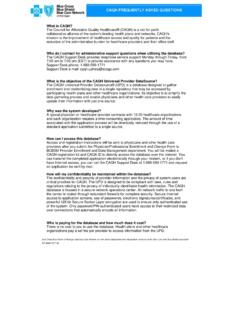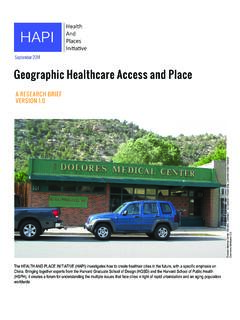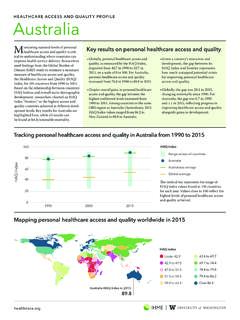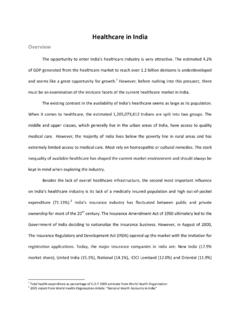Transcription of DEVELOPING STRATEGIES FOR IMPROVING HEALTH CARE …
1 H N P D i s c u s s i oN P aPe Rabout this series is produced by the HEALTH , Nutrition, and Population Family (HNP) of the World Bank s Human Development Network. The papers in this series aim to provide a vehicle for publishing preliminary and unpolished results on HNP topics to encourage discussion and debate. The findings, interpretations, and conclusions expressed in this paper are entirely those of the author(s) and should not be attributed in any manner to the World Bank, to its affiliated organizations or to members of its Board of Executive Directors or the countries they represent. Citation and the use of material presented in this series should take into account this provisional character. For free copies of papers in this series please contact the individual authors whose name appears on the paper.
2 Enquiries about the series and submissions should be made directly to the Editor Homira Nassery or HNP Advisory Service tel 202 473-2256, fax 202 522-3234). For more information, see also woRlD baNk1818 H Street, NWWashington, DC USA 20433 Telephone: 202 473 1000 Facsimile: 202 477 6391 Internet: : DEVELOPING STRATEGIES FOR IMPROVING HEALTH care DELIVERYG uide to Concepts, Determinants, Measurement, and Intervention DesignElizabeth H. Bradley, Sarah Pallas, Chhitij Bashyal, Peter Berman and Leslie CurryJune 2010 DEVELOPING STRATEGIES FOR IMPROVING HEALTH care DELIVERY Guide to Concepts, Determinants, Measurement, and Intervention Design Elizabeth H. Bradley, PhD Sarah Pallas, MPhil Chhitij Bashyal, BA Peter Berman, PhD Leslie Curry, PhD June, 2010 ii HEALTH , Nutrition and Population (HNP) Discussion Paper This series is produced by the HEALTH , Nutrition, and Population Family (HNP) of the World Bank's Human Development Network.
3 The papers in this series aim to provide a vehicle for publishing preliminary and unpolished results on HNP topics to encourage discussion and debate. The findings, interpretations, and conclusions expressed in this paper are entirely those of the author(s) and should not be attributed in any manner to the World Bank, to its affiliated organizations or to members of its Board of Executive Directors or the countries they represent. Citation and the use of material presented in this series should take into account this provisional character. For free copies of papers in this series please contact the individual author(s) whose name appears on the paper. Enquiries about the series and submissions should be made directly to the Editor, Homira Nassery Submissions should have been previously reviewed and cleared by the sponsoring department, which will bear the cost of publication.
4 No additional reviews will be undertaken after submission. The sponsoring department and author(s) bear full responsibility for the quality of the technical contents and presentation of material in the series. Since the material will be published as presented, authors should submit an electronic copy in a predefined format (available at on the Guide for Authors page). Drafts that do not meet minimum presentational standards may be returned to authors for more work before being accepted. For information regarding this and other World Bank publications, please contact the HNP Advisory Services at (email), 202-473-2256 (telephone), or 202-522-3234 (fax). 2010 The International Bank for Reconstruction and Development / The World Bank 1818 H Street, NW, Washington, DC 20433 All rights reserved.
5 Iii HEALTH , Nutrition and Population (HNP) Discussion Paper DEVELOPING STRATEGIES for IMPROVING HEALTH care Delivery: A User s Guide to Concepts, Determinants, Measurement, and Intervention Design Elizabeth H. Bradley,a Sarah Pallas,a Chhitj Bashyal,a Leslie Curry,a Peter Bermanb a Yale Global HEALTH Leadership Institute, Yale School of Public HEALTH , New Haven, USA b HEALTH , Nutrition, and Population Unit, Human Development Network, World Bank, Washington DC., USA Paper prepared for World Bank, Washington DC., USA Abstract: This report is a user s guide for defining, measuring, and IMPROVING the performance of HEALTH service delivery organizations. We define six core performance domains: quality , efficiency, utilization, access , learning, and sustainability and provide a compendium of metrics that have been used to measure organizational performance in each of these six domains.
6 The compendium, which includes 116 distinct categories of metrics, is based on a detailed literature review of peer-reviewed empirical studies of HEALTH care organizational performance in World Bank client countries. We include a bibliography of studies that have used these measures. Based on our reading of the literature, we define seven major strategy areas potentially useful for IMPROVING performance among HEALTH care organizations: 1) standards and guidelines, 2) organizational design, 3) education and training, 4) process improvement and technology and tool development, 5) incentives, 6) organizational culture, and 7) leadership and management. We provide illustrations of facility-level interventions within each of the strategy areas and highlight the conditions under which certain STRATEGIES may be more effective than others.
7 We propose that the choice of strategy targeted at organizational level to improve performance should be informed by the identified root causes of the problem, the implementation capabilities of the organization, and the environmental conditions faced by the organization. Measuring and IMPROVING organizational performance is complex because organizations are diverse and dynamic. Users of this guide should take away a toolkit of concepts and methods that can help them identify which questions to ask and how to answer them in the context of defining, measuring, and IMPROVING performance of HEALTH service delivery organizations. Having this broad set of tools with which to understand and enhance organizational performance can contribute to IMPROVING HEALTH service delivery and ultimately HEALTH outcomes.
8 Keywords: HEALTH care delivery, user guide, quality improvement, organizational performance, strategic development iv Disclaimer: The findings, interpretations and conclusions expressed in the paper are entirely those of the authors, and do not represent the views of the World Bank, its Executive Directors, or the countries they represent. Correspondence Details: Peter Berman, 1818 H St. NW, Washington DC., 20433 USA, tel: 202-458 2676, fax: 202-522 3234, Email: v Table of Contents VII HOW TO USE THIS GUIDE .. VII ACKNOWLEDGEMENTS .. IX I. MEASURING ORGANIZATIONAL PERFORMANCE IN HEALTH care DELIVERY: SIX OUTCOMES .. 1 quality .. 3 Efficiency .. 3 Utilization .. 4 access .. 4 5 Sustainability .. 5 Empirical Measures of Performance Domains in World Bank Client Countries.
9 5 II. DETERMINANTS OF ORGANIZATIONAL PERFORMANCE: THEORETICAL 7 BRIEF HISTORY OF ORGANIZATIONAL BEHAVIOR AND ORGANIZATIONAL THEORY .. 7 COMPARING OB/OT WITH ECONOMICS, PSYCHOLOGY, AND SOCIOLOGY .. 10 Economics .. 10 Psychology .. 11 Sociology .. 12 CONCEPTUAL FRAMEWORKS OF ORGANIZATIONAL PERFORMANCE WITHIN HEALTH SYSTEMS .. 14 II D. DETERMINANTS OF HEALTH SERVICE DELIVERY ORGANIZATION PERFORMANCE .. 17 CREATING ENABLING ENVIRONMENTAL CONDITIONS .. 18 III. STRATEGIES FOR IMPROVING ORGANIZATIONAL PERFORMANCE: A CLASSIFICATION SYSTEM .. 19 IV. IDENTIFYING AREAS FOR PERFORMANCE IMPROVEMENT PROGRAMS: METHODS .. 24 SELECTING MEASURES FOR ASSESSING ORGANIZATIONAL PERFORMANCE .. 24 Principle 1: Include Performance Metrics from Each Intermediate Outcome Domain.
10 24 Principle 2: Use Existing Data Sources Where Possible .. 25 Principle 3: Test Reliability and Validity of Metrics in the Context of Interest .. 25 Principle 4: Weigh Costs and Benefits of Internal and External Data Collection .. 25 Principle 5: Engage Stakeholders in Assessment Process .. 26 Principle 6: Estimate Resources Required for Data 26 Principle 7: Align Data Collection Methods to Fit with Domain .. 26 IDENTIFYING PERFORMANCE GAPS USING DIAGNOSTIC ASSESSMENT RESULTS .. 27 Within-Country Comparison .. 27 Cross-Country Comparison .. 27 Comparison with Domestic or International 28 ASSESSING ROOT CAUSES OF PERFORMANCE GAPS .. 28 Multidisciplinary Teams .. 28 vi Qualitative and Mixed Methods .. 29 Root Cause Analysis .. 29 SELECTING STRATEGIES .. 29 Assessing Environmental Conditions.



















